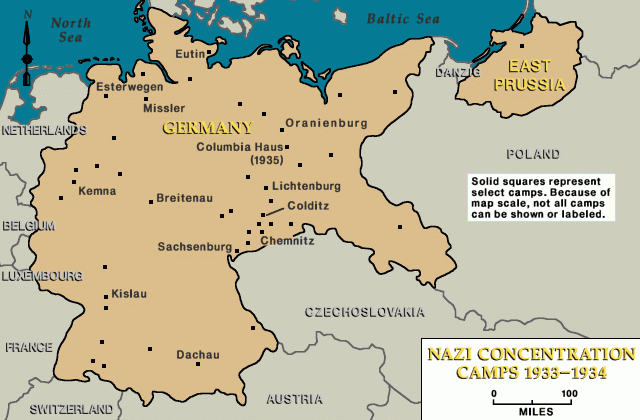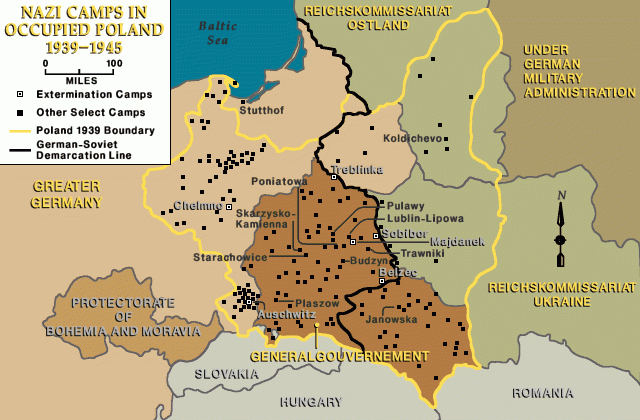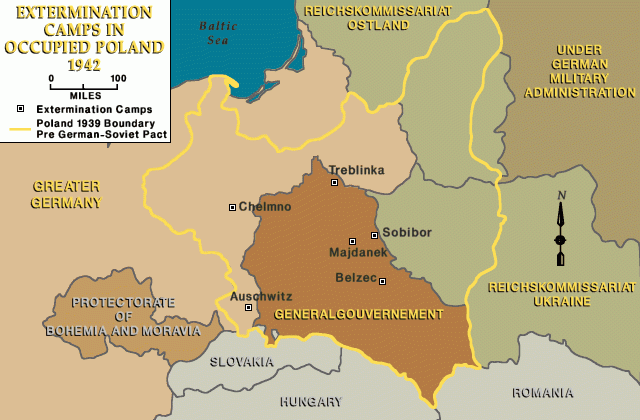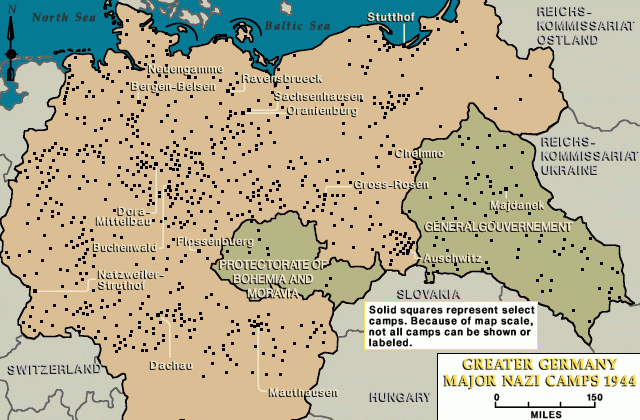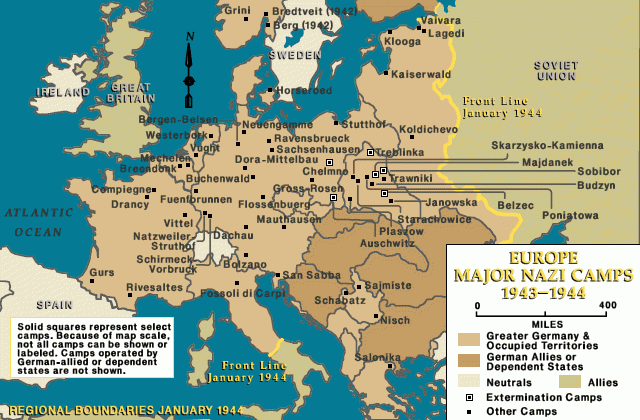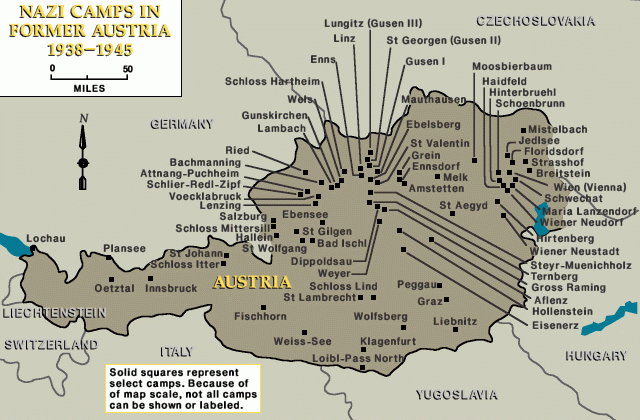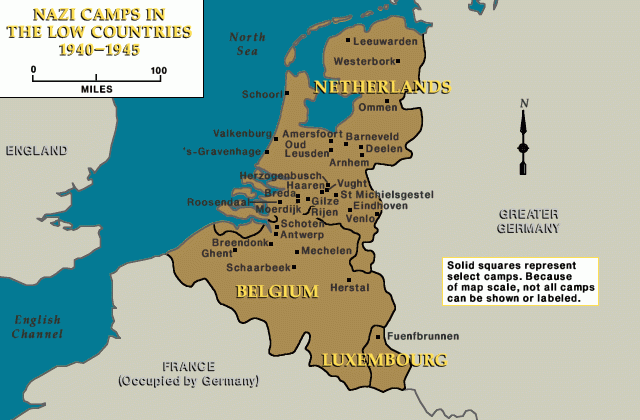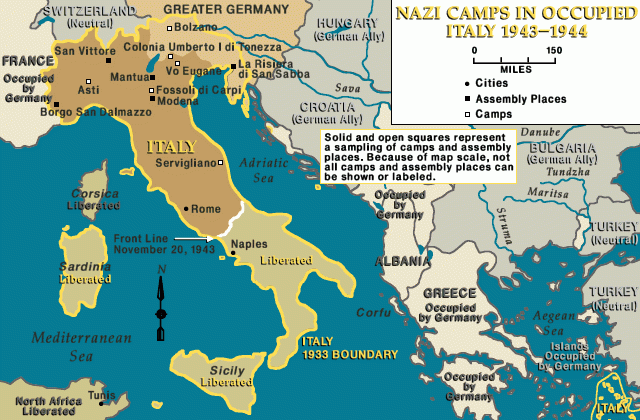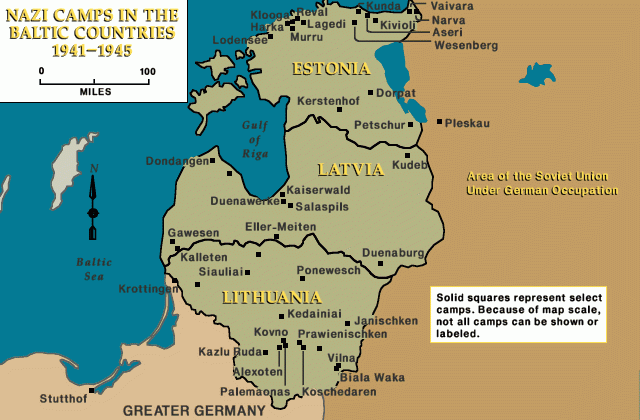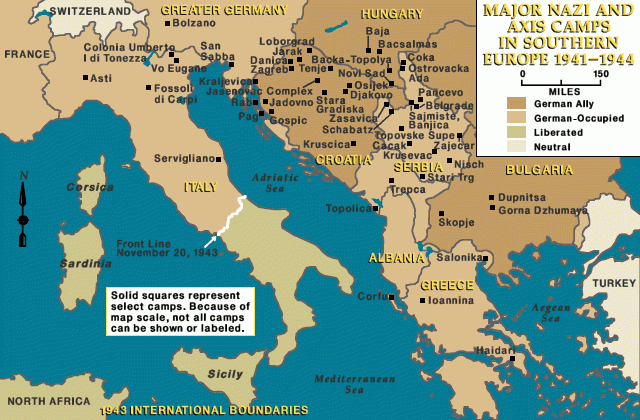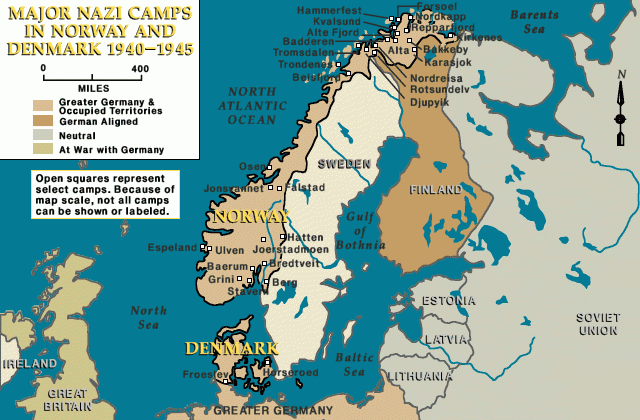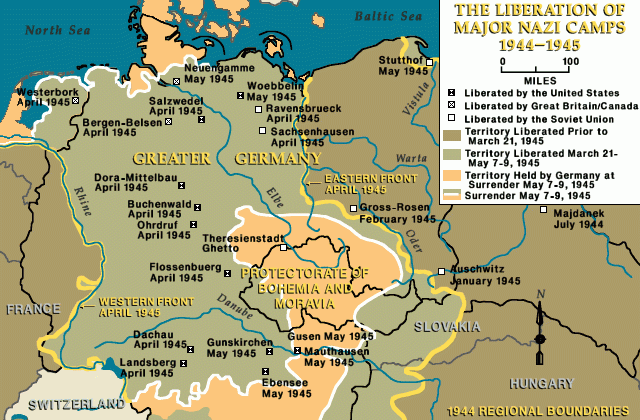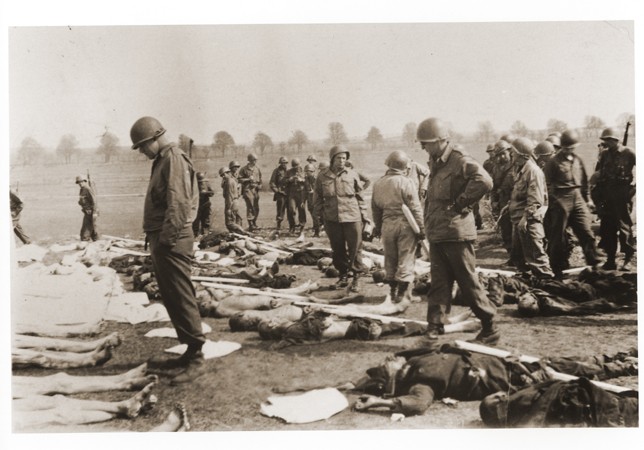
Concentration Camp System: In Depth
The camp system was extensive. It included concentration camps, labor camps, prisoner-of-war camps, transit camps, and killing centers.
German authorities under National Socialism established a variety of detention facilities to confine those whom they defined as political, ideological, or racial opponents of the regime. In time their extensive camp system came to include concentration camps, where persons were incarcerated without observation of the standard norms applying to arrest and custody; labor camps; prisoner-of-war camps; transit camps; and camps which served as killing centers, often called extermination camps or death camps.
In the earliest years of the Third Reich, various central, regional, and local authorities in Germany established concentration camps to detain political opponents of the regime, including German Communists, Socialists, trade unionists, and others from left and liberal political circles. In the spring of 1933, the SS established Dachau concentration camp, which came to serve as a model for an expanding and centralized concentration camp system under SS management.
Camp Administration
During 1934, Reichsführer SS (SS chief) Heinrich Himmler centralized those camps that held prisoners under orders of “protective custody” (Schutzhaft) under an agency called the Inspectorate of Concentration Camps (Inspekteur der Konzentrationslager; IKL). Himmler appointed Dachau concentration camp commander Theodor Eicke as chief of the IKL. In 1939, Richard Glücks replaced Eicke as Inspector of Concentration Camps; he held this position until 1945.
Subordinate to the SS Main Office from 1934 until 1939 and the SS Operations Main Office from 1939 until early 1942, the IKL became a department of the SS Economic-Administrative Main Office (SS-Wirtschafts-Verwaltungshauptamt; WVHA) in March 1942. This move corresponded to Himmler's decision to engage concentration camp labor more intensively in support of the German war effort.
Named for the insignia they wore on their uniform collar lapels, the SS Death's-Head Units (SS-Totenkopfverbände; SS-TV), later called SS Death's-Head Battalions (Sturmbann) and, eventually, Regiments (Standarten), commanded, administered, and guarded the concentration camps. Subordinated to the IKL, these units came to be renowned for their cruelty.
The German Security Police (Sicherheitspolizei; Sipo) had exclusive responsibility for arrest as well as orders for incarceration, release, execution, or other “official” disciplinary punishment. The Security Police was incorporated into the Reich Main Office for Security (Reichssicherheitshauptamt; RSHA) along with the SS Security Service (Sicherheitsdienst; SD) in 1939. It consisted of two branches of the pre-Nazi police detective forces: the German Political Police detective agencies, centralized and renamed the Secret State Police (Gestapo, for Geheime Staatspolizei) in 1934, investigated politically motivated crime; while the Criminal Police Detective agencies, centralized in 1936–1937, investigated crime that lacked apparent political motive.
Outside the Laws of the German State
The IKL, however, was responsible for the concentration camp prisoner from the moment he or she entered the camp until the moment he or she died in the camp or was released. The camp commandant and the SS Death's-Head Battalion personnel were responsible for constant “unofficial” cruelty that often led—and was intended to lead—to “unofficial” killings. These deaths each had to be reported to the Security Police. They were routinely written up as “suicides,” “accidental” deaths, and “justified killings” of prisoners who were “trying to escape,” “assaulting a guard,” “sabotaging production,” or “inciting prisoners to revolt.” The camp authorities also reported murders as deaths from acute illness, such as “weak heart” or “interruption of circulation.”
From 1933, the concentration camp system, including its prisoners and its guards, was not subject to review by any judicial or administrative authorities outside of the SS and police apparatus. Based on an extra-legal jurisdiction authorized by Hitler as Führer, the concentration camp literally stood outside the laws of the German state. It was intended to serve as a detention center for persons whom the Nazi leaders deemed to be a subversive danger to the German race. Incarceration in a concentration camp was rarely linked to a specific crime or actual subversive activity. The SS and police ordered incarceration based on their suspicion that an individual person either had committed a crime or engaged in subversive activity or would likely commit a crime or engage in a subversive activity in the future.
Who was Incarcerated?
Hence, individuals could be incarcerated in concentration camps indefinitely
- without ever being charged for a specific act;
- after having been acquitted on charges relating to a specific crime;
- upon release from prison after serving a sentence handed down by a German court for a specific act;
- or because the SS and police authorities deemed that individual—often on the basis of alleged racial inferiority or alleged racially driven “hostility to Germany”—was a danger to German society.
After the SS leadership, with Hitler's blessing, detached the pre-Nazi police detective forces from state administrative and judicial oversight in the years 1933–1936, only the centralized SS and police authorities could determine who was a danger to the German “race” and order the incarceration of such persons in a concentration camp. For persons perceived to be political and racial opponents of the Reich, the Gestapo issued “protective custody” (Schutzhaft) orders, which authorized the incarceration in the camps of Jews, Social Democrats, Communists, liberals, Freemasons, Jehovah's Witnesses, clergy who opposed the Nazis, members of national opposition movements, non-Germans in general after Germany began to occupy Europe, and any others whose behavior—real or perceived—could be interpreted as politically motivated opposition.
For persons whose real or perceived behavior or actions were considered criminal but non-political in nature, or socially deviant so as to create a so-called danger to German society, the Criminal Police office issued “preventative arrest” (Vorbeugungshaft) orders. Under these orders, which were often motivated more by racial and social prejudice than by actual criminal violations, Roma and Sinti (Gypsies), so-called asocials, repeat criminal offenders, gay men, and so-called security suspects were incarcerated in the concentration camps. Although the language of these arrest orders contained limits on the time during which a prisoner could be incarcerated, in practice incarcerations were routinely extended indefinitely. After World War II began, Himmler forbade in general the release of concentration camp prisoners for the duration of the war.
Source of Forced Labor
In addition to serving as detention centers for persons deemed to be of danger to the Reich, the concentration camp system served two other key purposes of the Nazi regime. First, corresponding to a close relationship between the Inspectorate of Concentration Camps and the business and administrative offices of the SS, the camps were to be the source of inexpensive forced labor for SS-owned or operated businesses. After 1938 and well into World War II, concentration camp labor was deployed in producing construction materials for actual SS-managed construction projects (including the expansion of existing camps and the construction of new camps).
In exceptional cases, concentration camp prisoners were “leased” to private firms, such as the I.G. Farben synthetic fuel and rubber plants established in 1941 in Monowitz in Upper Silesia, near the Auschwitz concentration camp. After the incorporation of the camps into the WVHA in 1942, the SS increasingly engaged concentration camp prisoners in producing for the German war effort, deploying them, still under SS guard, to German state-owned firms and private firms, which compensated the SS for the increasingly scarce labor.
Systematic Murder
The concentration camps, standing outside the reach of the German justice authorities, had always been places where the SS could kill prisoners. After the beginning of the war, however, the camps increasingly became sites for the systematic murder of individuals or small groups of persons.
Such groups included: Soviet prisoners of war selected by Gestapo officials as particularly dangerous; members of national resistance groups; persons deemed by the Criminal Police (Kripo) to be particularly violent criminals; groups of partisans, real or perceived; “Night and Fog” prisoners from western Europe; Polish or Soviet civilian forced laborers in Germany, who were then alleged to have had sexual relations with German women or to have committed a violent crime; and recaptured US and British military officers, who had escaped from prisoner-of-war camps and were to be killed under the provisions of the so-called Bullet Decree of 1944.
Such prisoners, like the European Jews who were murdered upon arrival in the gas chambers at the killing centers, were never officially registered as prisoners, but were killed usually within 24 hours of arrival. Recognizing the increasing numbers of these small-scale killing operations and because they needed an efficient way to kill prisoners who had become too weak to work, the SS authorities equipped several concentration camps with gas chambers during 1941-1942.
Even before the war, the camp system expanded with the construction of the major camps of
- Sachsenhausen (1936)
- Buchenwald, near Weimar (1937)
- Flossenbürg (1938)
- Mauthausen (1938)
- the women's concentration camp Ravensbrück (1939)
- Auschwitz (1940), which would later also serve as a killing center
- Natzweiler in Alsace (1941)
As the need for prisoner labor increased, especially after the beginning of World War II, the SS authorities in these major camps established satellite camps. Buchenwald, for example, had 88 satellite camps, or subcamps, by the end of war in 1945. Some satellite camps, like Gross-Rosen and Neuengamme, both subcamps of Sachsenhausen, grew so large that they became concentration camps in their own right.
Expanding Prisoner Populations
Most prisoners in the early concentration camps represented real or perceived political opponents of the regime. However, as time went on, the prisoner population expanded to include ideological and religious dissenters, such as Jehovah's Witnesses and dissident members of the clergy. The prisoner population also expanded to include individuals whose behavior did not comply with existing social norms, such as gay men, the “work-shy,” vagrants, other so-called “asocials,” and Roma, who, to Nazi leaders, represented at once an alien racial and criminal element on German soil. Habitual criminals were also incarcerated in concentration camps beginning in the 1930s, often after they had served their legitimate sentences in prison.
After the Kristallnacht ("Night of Crystal,” more commonly known as “Night of Broken Glass") pogroms in November 1938, SS and police officials conducted mass arrests of adult male Jews and imprisoned them in camps such as Dachau, Buchenwald, and Sachsenhausen. The particularly brutal treatment of Jews in the concentration camps served as further impetus for German and Austrian Jews to emigrate.
The outbreak and expansion of war radically altered the makeup and composition of the concentration camp system. The camp population expanded dramatically with the arrival of foreign forced laborers, foreign political opponents and resistance fighters, and prisoners of war.
Implementation of the "Final Solution"
Before the general deportation of Jews out of the so-called Greater German Reich began in October 1941, the burgeoning prisoner population of many concentration camps on German soil inspired some of the initial prisoner selections. SS doctors and so-called euthanasia functionaries conducted these selections. Beginning in spring of 1941, German officials sent ill and exhausted prisoners from Dachau, Sachsenhausen, Buchenwald, Mauthausen, Flossenbürg, Gross-Rosen, Niederhagen, Neuengamme, Ravensbrück, and Auschwitz to their deaths at various euthanasia killing centers under the auspices of Operation 14f13, the extension of the so-called euthanasia program to the concentration camp system.
During World War II, Nazi doctors also performed medical experiments on prisoners in some camps. Experiments to test pharmaceuticals and medical treatments, formulate rescue and survival strategies for Axis troops in the field, devise efficient and economic methods of mass sterilization, and underpin Nazi racial and antisemitic theories claimed the health and lives of thousands of concentration camp prisoners.
One of the most significant events to alter the makeup of the concentration camp system was the decision to deport and systematically murder the European Jews. To facilitate this "Final Solution" (the physical annihilation of the Jews), SS and police officials established four killing centers in German-occupied Poland exclusively for this purpose: Chelmno, Belzec, Sobibor, and Treblinka. The SS and police staff at each of these camps used carbon monoxide gas to murder Jews in large numbers. The SS establishment also constructed one killing center in the concentration camp system. Auschwitz II, better known as Auschwitz-Birkenau, began killing operations in spring 1942. In Auschwitz-Birkenau, the SS had within the concentration camp system a killing center that had four gas chambers and that, at the height of the deportations, could kill up to 6,000 Jews each day.
In order to ensure an efficient flow of Jews from German-occupied countries, German officials and their collaborators established transit camps, such as Westerbork in the Netherlands, or Drancy in France, from which SS and police officials coordinated the deportation of French Jews and Jews on French soil, primarily to Auschwitz. In Auschwitz II, planners of the “Final Solution,” aiming at greater efficiency, used the pesticide Zyklon B (prussic acid) to kill prisoners by means of gas. Beginning in 1941, SS authorities constructed gas chambers to kill smaller groups of prisoners as part of “routine” operations at Auschwitz I, Lublin/Majdanek, Sachsenhausen, Mauthausen, and other concentration camps.
Evacuations and Liberation
As the Third Reich began to collapse, thousands of prisoners in German-occupied territories were sent on forced marches to the German interior in order to prevent the mass capture of prisoners by Allied forces. Surviving prisoners described these brutal ordeals as “death marches,” due to the high mortality rate and the ruthlessness with which the SS guards shot those unable to keep up. Due to both the forced marches and the collapse of supply shipments to the camps during the last winter of the war, the death count among prisoners from starvation, disease, and exposure increased dramatically. Historians estimate that nearly half of the more than 700,000 prisoners left in the concentration camp system in January 1945 had died by the end of May. Hundreds more died even after liberation because their bodies had sustained too much abuse to permit survival. In the last months of war, the discovery of the horrors of the German camp system by Allied units brought the staggering scope of Nazi atrocities to the attention of the world.
Scholars have estimated that the Nazi regime incarcerated hundreds of thousands, even millions of people in the concentration camp system between 1933 and 1945. It is difficult to estimate the total number of deaths. One estimate notes a range of between 795,889 and 955,215 deaths of registered prisoners, excluding the deaths of registered Jewish prisoners at Auschwitz and Lublin/Majdanek. If one counts the number of Jews (registered and unregistered) killed at Auschwitz (approximately one million) and at Lublin/Majdanek (at least 89,000), the number of deaths in the concentration camp system ranges between 1,885,889 and 2,045,215.
Critical Thinking Questions
- Explain the systematic nature of the attempt to annihilate the Jews of Europe
- What kind of a society or government may be a precondition to implementing such a systematic effort?


